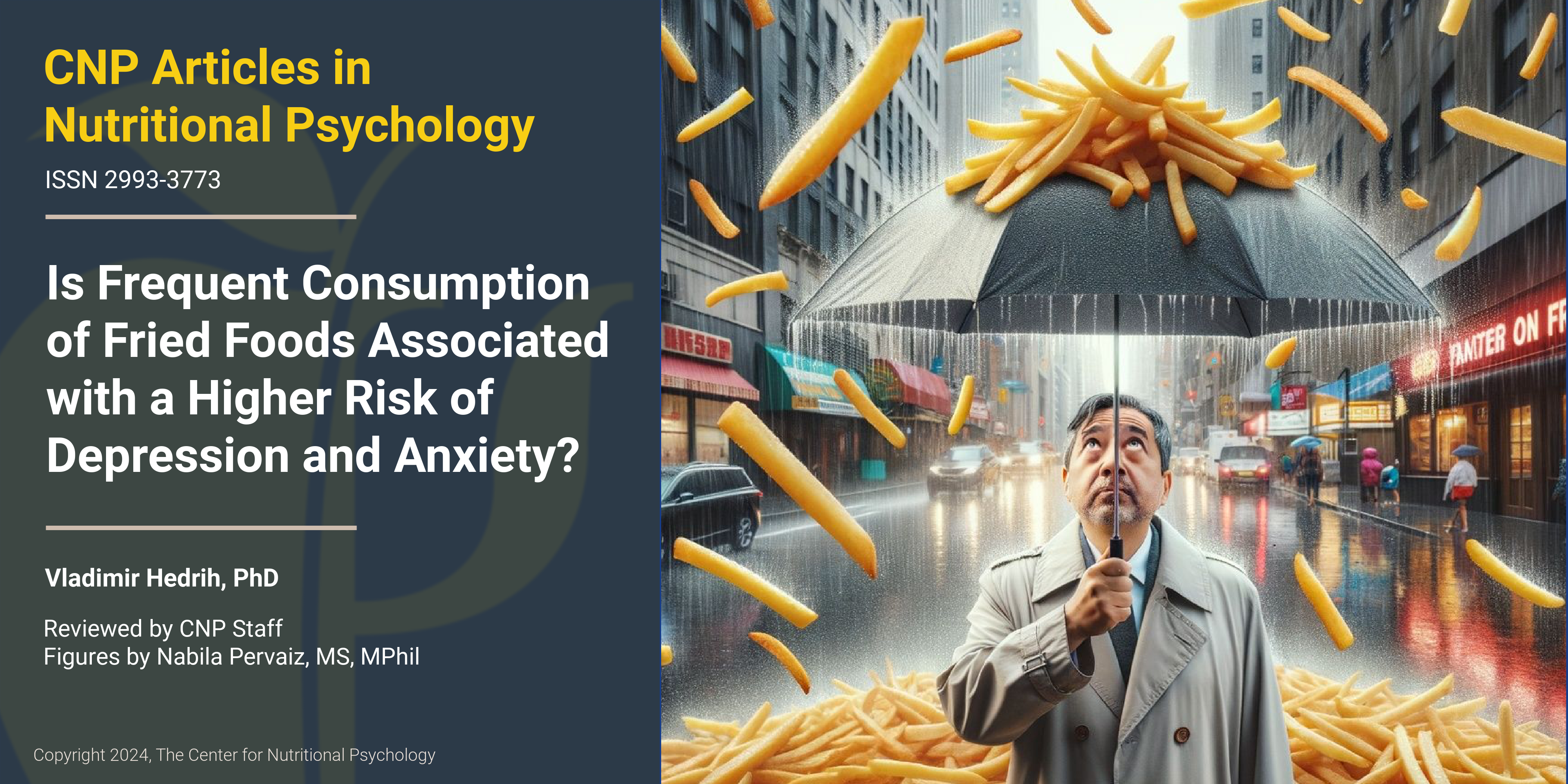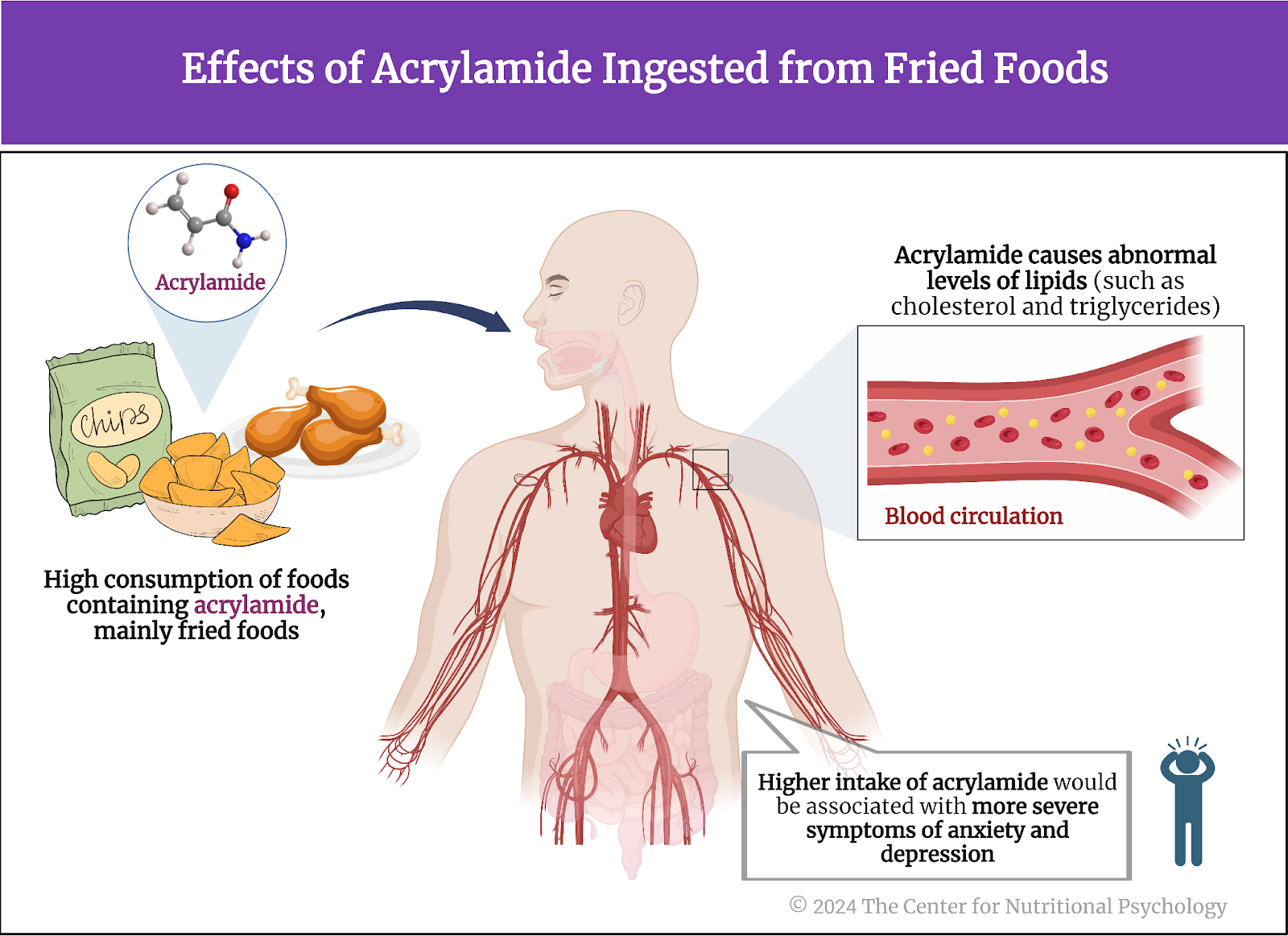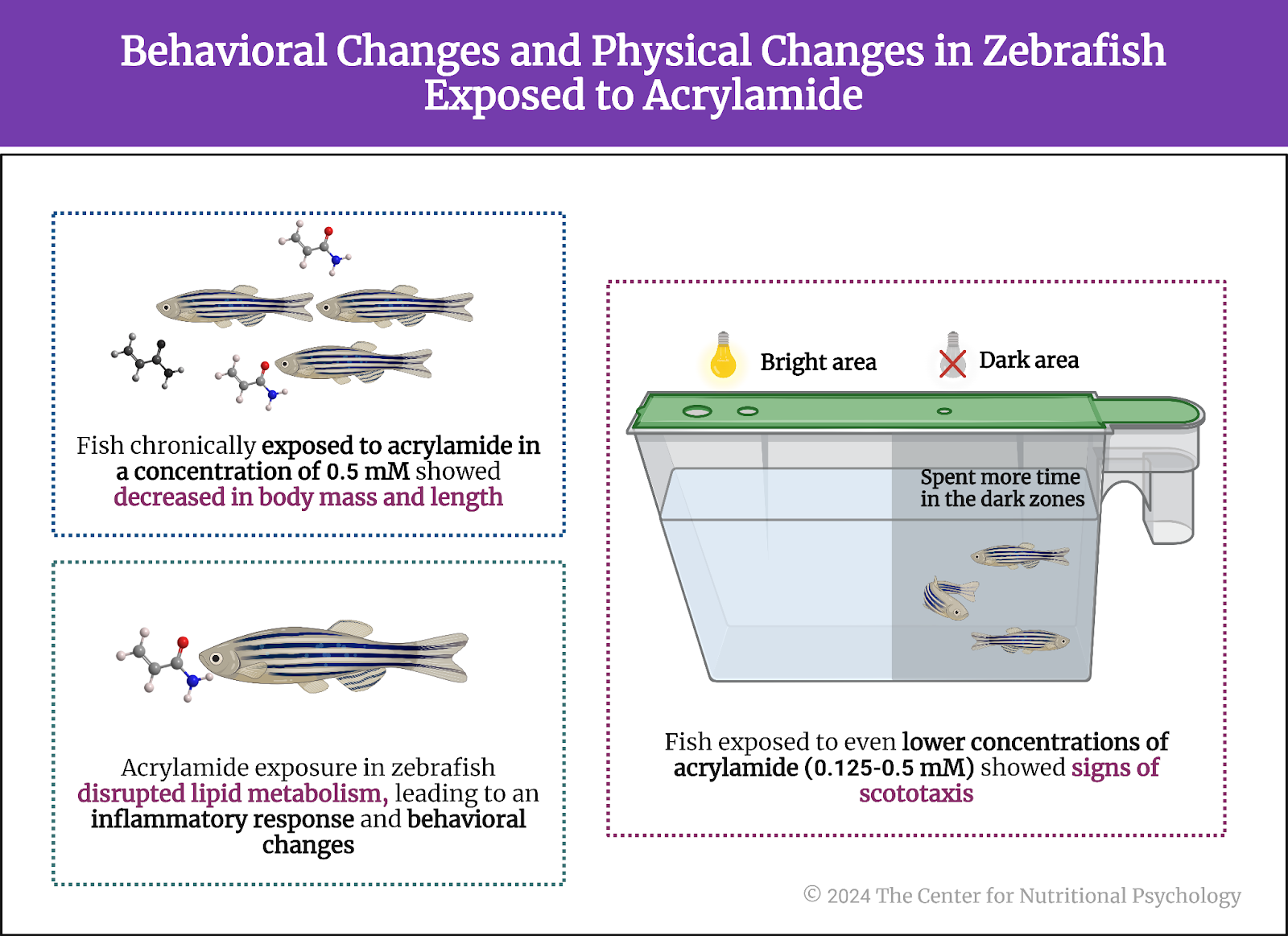Frequent Consumption of Fried Foods is Associated With a Slightly Higher Risk of Depression and Anxiety

Listen to this Article
- A study of UK Biobank data published in PNAS reported that frequent consumption of fried food increased the risk of anxiety by 12% and the risk of depression by 7%.
- Fried potato consumption was specifically associated with a somewhat increased risk of depression and anxiety symptoms.
- An experiment on zebrafish confirmed that chronic exposure to acrylamide, a substance created when food is fried, creates anxiety-like symptoms in these fish.
The consolidation of research in the diet-mental health relationship within nutritional psychology has shown that our food choices and patterns can influence our moods and state of mind, and our moods and state of mind can influence our food choices and patterns (NPRL). People tend to eat when stressed or bored (Dicker-Oren et al., 2022; Stevenson et al., 2023). They can also feel angry when hungry (called hanger), in which one experiences anger due to hunger (Hedrih, 2023a).
Food choices and patterns can influence our moods and state of mind, which can influence our food choices and patterns
But could our dietary choices be associated with serious mental health disorders? Disorders like anxiety or depression?
Depression and anxiety
Depression and anxiety are two of the most frequent mental health disorders. Depression is characterized by persistently low mood and a lack of interest or pleasure in activities. A depressed individual will often feel sad, hopeless, and with little energy. This can lead to adverse changes in appetite and sleep patterns, but sometimes also thoughts of suicide.
Anxiety, on the other hand, is a condition marked by persistent and excessive worry that interferes with daily activities. It is typically accompanied by physical symptoms like restlessness, fatigue, difficulty concentrating, irritability, muscle tension, and sleep disturbances. While both conditions involve emotional distress, depression primarily affects mood and motivation, whereas anxiety is centered around fear and nervousness (see Figure 1).

Figure 1. Characteristics of and differences between depression and anxiety
Studies indicate that the share of individuals suffering from depression has been increasing both in the U.S. and globally in the past decades (Steffen et al., 2020; Weinberger et al., 2018). Anxiety and depression often occur together. Estimates state that the number of people suffering from anxiety increased after the global COVID-19 pandemic by 26% (Wang et al., 2023).
The number of people suffering from anxiety increased after the global COVID-19 pandemic by 26% (Wang et al., 2023)
Diet and mental health
While the precise causes of anxiety and depression are unknown, a great number of genetic, biological, environmental, and psychological factors have been found to play a role in their development. Recent studies have also linked certain dietary habits, such as the consumption of ultra-processed foods or sweetened beverages, to increased depression risks (Hedrih, 2023b; Samuthpongtorn et al., 2023).
Other researchers bring into focus the so-called Western diet, a diet based on fried and processed foods, refined grains, sugary products, and beer, as a dietary pattern associated with an increased risk of depression and anxiety (Wang et al., 2023). Within this diet, researchers single out fried food as particularly contributing to these adverse links with mental health.
The Western diet is a dietary pattern associated with an increased risk of depression and anxiety
Fried food and health
Frying is a method of food preparation that people widely use at home and in restaurants. However, the process of frying changes the nutrient composition of the food and can produce various hazardous compounds. One such substance is acrylamide. Acrylamide is created during the process of frying foods that are rich in carbohydrates, such as potatoes. Acrylamide is known to be toxic for neurons in higher concentrations. Studies have linked its prolonged intake to an increased risk of cardiovascular disease, neurological disorders, obesity, metabolic syndrome, and depression.
The process of frying changes the food’s nutrient composition and can produce various hazardous compounds
The current study
Study author Anli Wang and her colleagues wanted to examine the association between the intake of a substance found in fried food called acrylamide and depression and anxiety in a large sample from the general population. Acrylamide is a substance found in fried food.
These authors expected that high consumption of fried food and, consequently, higher intake of acrylamide would be associated with more severe symptoms of anxiety and depression. Ingested acrylamide would lead to abnormal levels of lipids, such as cholesterol and triglycerides, in the blood and inflammation. This would, in turn, impact the likelihood that depression or anxiety would develop (see Figure 2).

Figure 2. Effects of acrylamide ingested from fried foods
In this study, the authors analyzed human data from the UK Biobank and conducted an experiment on zebrafish.
The UK Biobank
The UK Biobank is a large-scale biomedical database and research resource containing in-depth genetic and health information from half a million UK participants. The project, which began in 2006 and is ongoing, aims to improve the prevention, diagnosis, and treatment of a wide range of serious and life-threatening illnesses.
UK Biobank participants provided blood, urine, and saliva samples and detailed health and lifestyle information, which researchers worldwide can access to conduct health-related research. Many valuable scientific discoveries and insights have come from this database, and new studies using UK Biobank data are continuously being published.
For this study, researchers analyzed data from 140,728 individuals from the UK Biobank. Of these, during the 11.3 years of follow-up, 8,294 had symptoms of anxiety, and 12,735 had depression symptoms (see Figure 3).

Figure 3. Study procedure
The Zebrafish experimentI
n addition to analyzing the UK Biobank data, the researchers conducted an experiment on zebrafish. This experiment exposed zebrafish groups to different acrylamide concentrations for 180 days. After the exposure period, they conducted a series of tests to evaluate anxiety-like symptoms in these fish. At the end of the experiment, they killed the fish and harvested their brains to analyze tissue changes.
Zebrafish are a small, freshwater fish species extensively used in biomedical research due to their genetic similarity to humans, transparent embryos that allow easy observation of developmental processes, and rapid reproduction.
These researchers looked for specific symptoms in zebrafish exposed to acrylamide –specifically thigmotaxis and scototaxis. Scototaxis is a tendency of fish to prefer darker areas over lighter ones in their environment. Thigmotaxis is a preference for staying close to physical objects or walls in their aquarium. In research, both of these tendencies are indications that the fish is experiencing anxiety-like conditions and that it is under stress. The more pronounced they are, the higher the anxiety-like conditions in the fish are.
UK Biobank People consuming fried food more often had somewhat higher risks of depression and anxiety
Results from the UK Biobank showed that individuals consuming at least one fried meal per day were more likely to be younger, male, and active smokers than those consuming fried food less often. After taking into account the age and sex of participants, statistical analyses showed that individuals consuming fried food more often were somewhat more likely to have anxiety and depression symptoms.
Notably, individuals consuming fried food were 12% more likely to have anxiety symptoms and 7% more likely to have symptoms of depression. Results of looking at specific food types highlighted fried potatoes and fried white meat. Consumption of each of these foods was associated with a 4% higher risk of anxiety and a 7% higher risk of depression. However, after adjusting for various other factors, the link with fried white meat consumption disappeared, but the one with fried potato consumption remained (see Figure 4).

Figure 4. Fried food consumption and depression and anxiety symptoms
Individuals consuming fried food were 12% more likely to have anxiety symptoms and 7% more likely to have symptoms of depression
Zebrafish exposed to acrylamide developed behaviors indicative of stress and anxiety
The experiment on zebrafish showed that fish chronically exposed to acrylamide in a concentration of 0.5 mM decreased in body mass and length. Fish exposed to even lower concentrations of acrylamide (0.125-0.5 mM) showed signs of scototaxis. They spent more time in the dark zones than zebrafish without this exposure. The time the fish spent in the dark zones was associated with the concentration of acrylamide used.
Other behavioral comparisons between zebrafish exposed to acrylamide and those in the control group also confirmed the finding about anxiety-like symptoms in fish exposed to this substance. Analysis of tissues of zebrafish showed that exposure to acrylamide disturbed their lipid metabolism and initiated an inflammatory response, which, in turn, likely led to the observed behavioral changes (see Figure 5).



Figure 5. Behavioral changes and physical changes in Zebrafish exposed to acrylamide
Conclusion
An analysis of UK Biobank data showed that individuals frequently consuming fried food have a slightly higher risk of having depression or anxiety symptoms. An experiment on zebrafish confirmed that chronic exposure to acrylamide, a substance created when food rich in carbohydrates is fried, might cause this link. Exposure to acrylamide can disturb the metabolism of lipids and initiate an inflammatory response that may, in turn, contribute to the development of anxiety and depression symptoms.
Chronic exposure to acrylamide, a substance created when food rich in carbohydrates is fried, might cause this link
These findings contribute to a better scientific understanding of the diet-mental health relationship (DMHR). They may help individuals and mental health practitioners prevent or better treat anxiety and depression conditions by modifying their diet. The insights brought by this study may also allow for the creation of better menus and meal plans in the hospitality industry and various institutional food services.
The paper “High fried food consumption impacts anxiety and depression due to lipid metabolism disturbance and neuroinflammation” was authored by Anli Wang, Xuzhi Wan, Pan Zhuang, Wei Jia, Yang Ao, Xiaohui Liu, Yimei Tian, Li Zhu, Yingyu Huang, Jianxin Yao, Binjie Wang, Yuanzhao Wu , Zhongshi Xu, Jiye Wang, Weixuan Yao, Jingjing Jiao, and Yu Zhang.
References
Dicker-Oren, S. D., Gelkopf, M., & Greene, T. (2022). The dynamic network associations of food craving, restrained eating, hunger and negative emotions. Appetite, 175(March), 106019. https://doi.org/10.1016/j.appet.2022.106019
Hedrih, V. (2023a). Food and Mood: Is the Concept of ‘Hangry’ Real? CNP Articles in Nutritional Psychology.
https://www.nutritional-psychology.org/food-and-mood-is-the-concept-of-hangry-real/
Hedrih, V. (2023b). Women Consuming Lots of Artificially Sweetened Beverages Might Have a Higher Risk of Depression, Study Finds. CNP Articles in Nutritional Psychology. https://www.nutritional-psychology.org/women-consuming-lots-of-artificially-sweetened-beverages-might-have-a-higher-risk-of-depression-study-finds/
Samuthpongtorn, C., Nguyen, L. H., Okereke, O. I., Wang, D. D., Song, M., Chan, A. T., & Mehta, R. S. (2023). Consumption of Ultraprocessed Food and Risk of Depression. JAMA Network Open, 6(9), e2334770. https://doi.org/10.1001/jamanetworkopen.2023.34770
Steffen, A., Thom, J., Jacobi, F., Holstiege, J., & Bätzing, J. (2020). Trends in prevalence of depression in Germany between 2009 and 2017 based on nationwide ambulatory claims data. Journal of Affective Disorders, 271, 239–247. https://doi.org/10.1016/J.JAD.2020.03.082
Stevenson, R. J., Bartlett, J., Wright, M., Hughes, A., Hill, B. J., Saluja, S., & Francis, H. M. (2023). The development of interoceptive hunger signals. Developmental Psychobiology, 65(2), 1–11. https://doi.org/10.1002/dev.22374
Wang, A., Wan, X., Zhuang, P., Jia, W., Ao, Y., Liu, X., Tian, Y., Zhu, L., Huang, Y., Yao, J., Wang, B., Wu, Y., Xu, Z., Wang, J., Yao, W., Jiao, J., & Zhang, Y. (2023). High-fried food consumption impacts anxiety and depression due to lipid metabolism disturbance and neuroinflammation. Proceedings of the National Academy of Sciences of the United States of America, 120(118). https://doi.org/10.1073/pnas.2221097120
Weinberger, A. H., Gbedemah, M., Martinez, A. M., Nash, D., Galea, S., & Goodwin, R. D. (2018). Trends in depression prevalence in the USA from 2005 to 2015: widening disparities in vulnerable groups. Psychological Medicine, 48(8), 1308–1315. https://doi.org/10.1017/S0033291717002781








Leave a comment